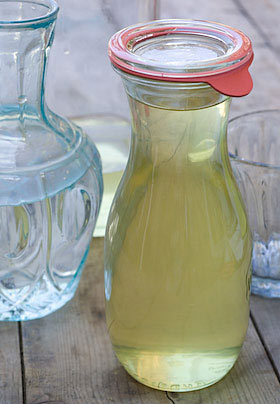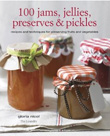FORAGING FOR ROSE HIPS
Tuesday October 12th 2010, 12:32 am

This is such a great time of year to go out foraging. I’m getting so used to collecting my ingredients for free, I can hardly imagine buying any from now on. As well as berries and fruits gathered from the hedgerows when out walking, the house is full of an abundance of other free stuff people have given me that requires attention; apples, pears, grapes, green tomatoes, cucumbers, quinces, all set to become jams, pickles, jellies and fruit butters. It is sometimes quite a facing to deal with it all but the opportunity to stock the pantry is just to good to pass up, so I feel compelled to endeavour to work my way through all these luscious ingredients before they disappear for another year.
It is amazing how much produce is out there going begging and often people with a plentiful supply of fruit have neither the time or inclination to do anything with it so are all too happy to give it away to someone who will make use of it. The more you let it be known that you are there to take these ingredients off others hands, the more stuff seems to turn up. Hence my kitchen smells of apples and quinces and I don’t have an empty basket or colander in the place.
Cordials and syrups are perfect comestibles to make yourself and this is when canning makes such sense. Whilst jams and pickles often have enough acidity, sugar and cooking time to ensure they’ve a good chance of staying safe enough to eat for months on end without water processing them (at least by European standards anyway), cordials must be either frozen or canned to help them keep for longer than a few weeks in the fridge. Smart delis and farm shops sell all sorts of cordials but they are really easy to make yourself. It is the pasturisation part that is the big mystery for most people.

Rosehip syrup is an old traditional recipe, known for being high in vitamin C, so therefore particularly good for you. It does of course contain sugar and is cooked for a while which must surely reduce the amount of vitamin C, but hey, it tastes really good. According to Wild Food by Roger Phillips, rose hips contain four times as much vitamin C as blackcurrant juice and twenty times as much as oranges, so even with a reduction from processing they appear to be stuffed full of goodness. It isn’t always so easy to find a plentiful supply of rosehips all in one go, in which case gather them whenever you see them and keep them in a container in the freezer until you have accrued enough. It is said that rosehips are best after a frost anyway but I find they’ve usually gone over by then so best not take the chance and miss them altogether. Making them into cordial thankfully helps avoid the fiddly and arduous job of removing the seeds from each hip, one by one, as they all come out in the jelly bag. The seeds are what impish schoolboys once used as itching powder in the good old days. I wouldn’t want them down the back of my liberty bodice.
HOW TO MAKE ROSEHIP SYRUP
Makes 1.5ltrs ( 2 1/2 pints)
1Kg (2 lbs) rosehips
2.5ltrs (4 1/2pts) water
450g (1lb) sugar
Wash and drain the rosehips and remove stems and stalks with scissors. Blitz them in a food processor, or put through a mincer, to help smash them up. Put half the water in a pan and bring to the boil, then add the rosehips bring back to the boil and remove from the heat. Leave to macerate for 20 minutes.
Pour into a jelly bag suspended over a bowl to collect the drips and leave for an hour or so. Boil the remaining water and add the pulp from the jelly bag, bringing back to the boil and removing from the heat exactly as before. Leave to macerate for 20 minutes then pour into the jelly bag, collecting the liquid that drains through and adding it to the first amount collected.
Prepare the water bath, jars and seals or bottles ready for canning. For more info about how to hot water process, refer to the guide here.
Pour the combined juice into a pan and boil it until reduced to approximately 900ml (1 1/2 pints). Add the sugar and stir over a low heat until dissolved. Turn up the heat and boil for 5 minutes. Pour into sterilised bottles, seal and process for 5 minutes. Leave till cold before testing the seals, label and store.

RHUBARB AND ANGELICA CORDIALIZED
Friday April 23rd 2010, 1:54 pm
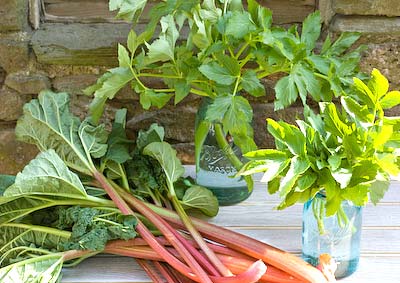
Month four Tigress’s can jam canning challenge and the chosen ingredient is herbs. This is a funny one, as herbs are a flavouring and sidekick rather than a main player ingredient so thinking cap required. Ingredient wise, this is where everybody needs good neighbours. Helen and Steve a few doors one side have a thriving patch of rhubarb but noone in the house enjoys rhubarb enough to make use of it. As explained in my last post (just yesterday) Jane’s garden, a few doors down on the other side, has angelica growing so can provide the herbal element needed to meet the can jam criteria. So both my ingredients couldn’t be more local, more seasonal or more freely available. Angelica can be used to offset the tartness of fruits such as currants, gooseberries and rhubarb so it is an ideal pairing.
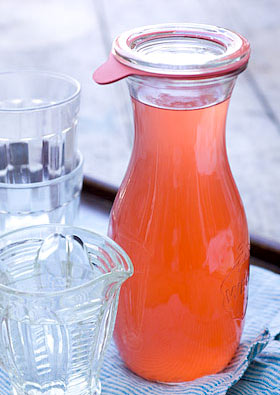
With the sun at last making an appearance and the need to get to grips with horticultural tasks, naturally my thoughts have turned to the need for cordial as a suitable refreshment whilst I work. I started looking for inspiration and found it in Fancy Pantry by Helen Witty. I’m liking the look and feel of this book, published in the US in 1986, found a while ago on Amazon. It is full of recipes for stocking your pantry, including some preserves, pickles and relishes, and for me, someone in the UK not so familiar with canning, it includes reassuring processing information where relevant. Since it arrived in the post I have spent many hours enjoying this book and there in the ‘sippin’ substances’ chapter a recipe for rhubarb nectar caught my eye and seemed a good starting point for my April Can Jam project. Cordials are really easy to make, like the first process of jelly making without the worry of achieving a set at the end.
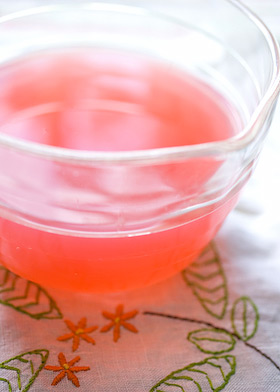
I am really pleased with the result. I used the angelica leaves and at my first attempt layered them with the rhubarb to let the flavours infuse. I didn’t feel that the angelica made its presence felt strongly enough so have devised another method to make an angelica syrup which is then added to the rhubarb. I’m going to be making lots more of this cordial, with and without the herbal note, as the resulting drink is supremely versatile and quite delicious. Simply serve as a refreshing drink diluted with still or fizzy water or as part of a more grown up cocktail, such as a pink gin fizz, made by mixing equal measures with gin over ice and topped up with soda and a sprig of mint. There is plenty of room for experimentation, you just have to watch that nothing you add overpowers the exquisite rhubarb flavour. The cordial is also a fabulous colour.
RHUBARB AND ANGELICA CORDIAL
Makes approx 1.7 litres (3 pints)
100g (3 1/2 oz) angelica fresh leaves
450g (1 lb) caster sugar
2kg (4 lbs) rhubarb
1.2ltrs (2 pints) water
Wash and drain the angelica and shake dry, then chop roughly and place in a dish in layers with half of the sugar sprinkled in between and over top to cover. Leave for 24 hours until the sugar has turned to syrup. Put into a pan and heat gently, stirring to be sure all the sugar has dissolved. Bring to the boil then remove from the heat, pour back in the dish and leave overnight. Return to the pan, bring to a simmer and cook gently until the leaves begin to look transparent, which should only take 5 minutes or so. Pour through a sieve to leave a clear syrup. This method should extract as much of the angelica flavour as possible. Cut the macerating time down as required if you are in a hurry.
Wash and drain the rhubarb, removing leaves and trimming the ends. Cut thicker stalks in half down the middle then chop into 1cm sized pieces. Place in a pan with the water, bring to the boil and simmer gently for 10 – 15 minutes until cooked through. Pour into a suspended jelly bag and leave overnight to drip through, catching the juice in a jug.
Prepare the canning bath and sterilised bottles. Place the rhubarb juice, angelica syrup and remaining sugar in a pan and heat gently, stirring all the time until the sugar is dissolved. Bring to the boil then remove from the heat, pour into your hot bottles, leaving the required headroom for your bottle type (mine shown in the picture looks like it has a bit too much headroom! I’ll do better next time) seal and process for 10 minutes. Leave till cold and label. For more info about how to hot water process, refer to the guide here.
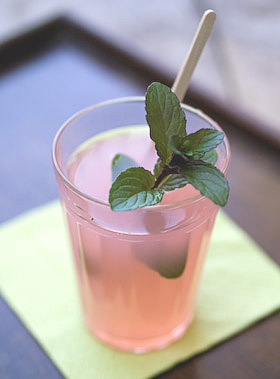
After candying the small quantity of angelica stems I had and using some of the leaves to make my rhubarb and angelica cordial, I still had some leaves left over. Hating the thought of wasting them I decided to make a second cordial. As the intention was to ‘can’ the cordial and I was worried whether it would be acidic enough to safely do this way, it seemed like a good idea to make it following a similar method you might use when making elderflower cordial. For this you include some lemon juice as well as a small amount of citric acid to help its keeping qualities. I have a stock of citric acid, bought a while back at my local chemist. I know some people find it difficult to get hold of but it can be found at home brew shops and on ebay as well if your pharmacy is unable to supply.
I wasn’t at first sure whether the lemon and citric acid rather overpowered the more subtle angelica flavour but I’ve just drunk a glass diluted down with sparkling mineral water and the flavour came through in a lovely distinctive way which sets it apart from the elderflower version.
ANGELICA CORDIAL
Makes approx 1.7 litres (3 pints)
1.2 litres (2 pts) water
900g (1 lb) caster sugar
200g (8 oz) angelica leaves, chopped
3 tsp citric acid
juice and zest of 2 lemons
Make a sugar syrup with the sugar and water by heating them together in a pan, stirring until all the sugar is dissolved and bringing to the boil. Remove from heat and add the citric acid. Put the angelica, lemon juice and zest in a bowl and pour the syrup over them. Cover the bowl and leave for 24 hours to macerate and infuse.
Strain through muslin and collect the liquid in a pan. If you are planning to can the cordial so it can be stored, prepare the canning bath and sterilise the bottles. Bring the cordial just to the boil then remove from the heat, pour into your hot bottles, leaving the required headroom for your bottle type, seal and process for 10 minutes. Remove from water bath and leave till cold then label. For more info about how to hot water process, refer to the guide here. This cordial will keep for several weeks unprocessed in the fridge but will store for up to a year unopened after processing.
